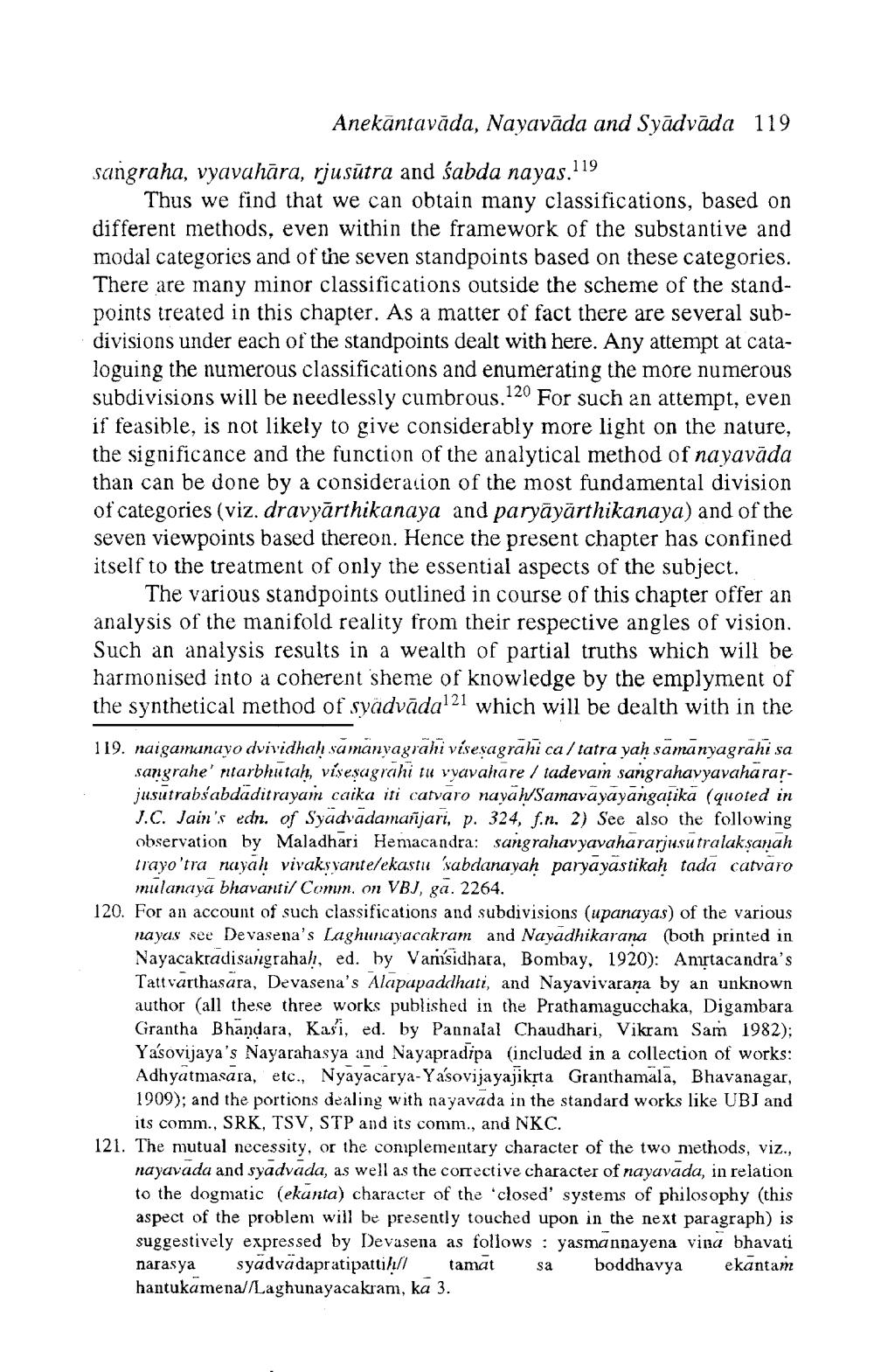________________
Anekāntavāda, Nayavāda and Svādvāda 119
sangraha, vyavahāra, rjusūtra and sabda nayas.119
Thus we find that we can obtain many classifications, based on different methods, even within the framework of the substantive and modal categories and of the seven standpoints based on these categories. There are many minor classifications outside the scheme of the standpoints treated in this chapter. As a matter of fact there are several subdivisions under each of the standpoints dealt with here. Any attempt at cataloguing the numerous classifications and enumerating the more numerous subdivisions will be needlessly cumbrous.120 For such an attempt, even if feasible, is not likely to give considerably more light on the nature, the significance and the function of the analytical method of nayavāda than can be done by a consideration of the most fundamental division of categories (viz. dravyārthikanaya and paryāyārthikanaya) and of the seven viewpoints based thereon. Hence the present chapter has confined itself to the treatment of only the essential aspects of the subject.
The various standpoints outlined in course of this chapter offer an analysis of the manifold reality from their respective angles of vision Such an analysis results in a wealth of partial truths which will be harmonised into a coherent sheme of knowledge by the emplyment of the synthetical method of syadvāda121 which will be dealth with in the
119. naigamunayo dvividhah samanvagrahi visesagrahica/ tatra yah samanyagrahi sa
sangrahe' ntarbhutah, visesagrahi tu vyavahare / tadevam sangrahavyavahararjusutrabs'abdaditrayam caika iti catvaro nayah/Samavayayangatika (quoted in J.C. Jain's edn. of Syadvadamañjari, p. 324, f.n. 2) See also the following observation by Maladhari Heniacandra: sangrahavyavahararjusu tralaksanah trayo'tra nayah vivaksvantelekastu sabdanayah paryayastikah tada catvaro
mulanaya bhavantil Comm. on VB), ga. 2264. 120. For an account of such classifications and subdivisions (upanayas) of the various
nayas see Devasena's Laghunayacakram and Nayadhikarana (both printed in Nayacakradisangrahah, ed. by Vamsidhara, Bombay, 1920): Amrtacandra's Tattvarthasara, Devasena's Alapapaddhati, and Nayavivarana by an unknown author (all these three works published in the Prathamagucchaka, Digambara Grantha Bhandara, Kasi, ed. by Pannalal Chaudhari, Vikram Sam 1982); Yasovijaya's Nayarahasya and Nayapradipa (included in a collection of works: Adhyatmasara, etc., Nyayacarya-Yasovijayajikrta Granthamala, Bhavanagar, 1909); and the portions dealing with nayavada in the standard works like UBI and
its comm., SRK, TSV, STP and its comm., and NKC. 121. The mutual necessity, or the complementary character of the two methods, viz.,
nayavada and syadvada, as well as the corrective character of nayavada, in relation to the dogmatic (ekanta) character of the closed' systems of philosophy (this aspect of the problem will be presently touched upon in the next paragraph) is suggestively expressed by Devasena as follows : yasmannayena vina bhavati narasya syadvadapratipattili/ tamat sa boddhavya ekantam hantukamena/ /Laghunayacakram, ka 3.




